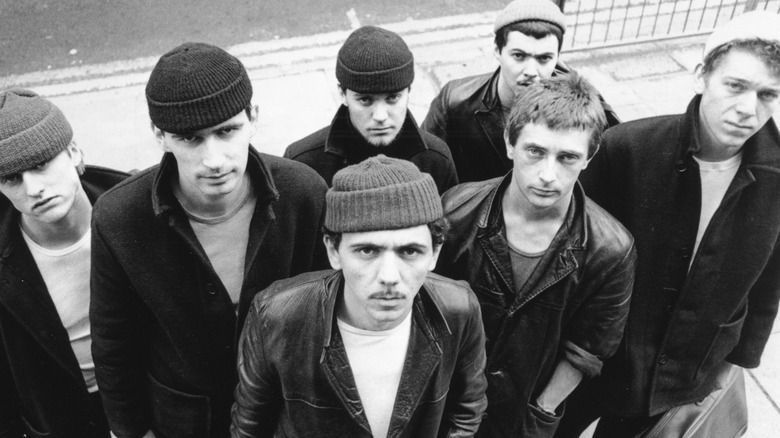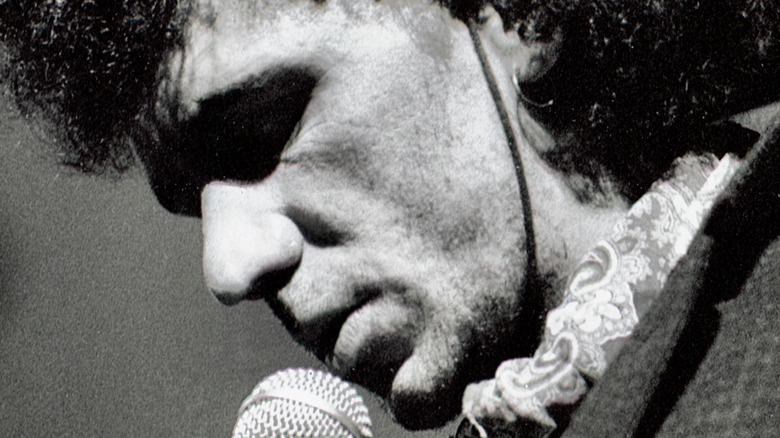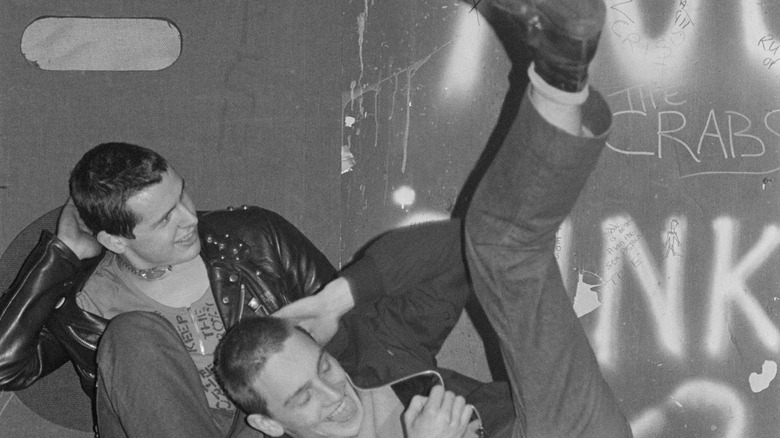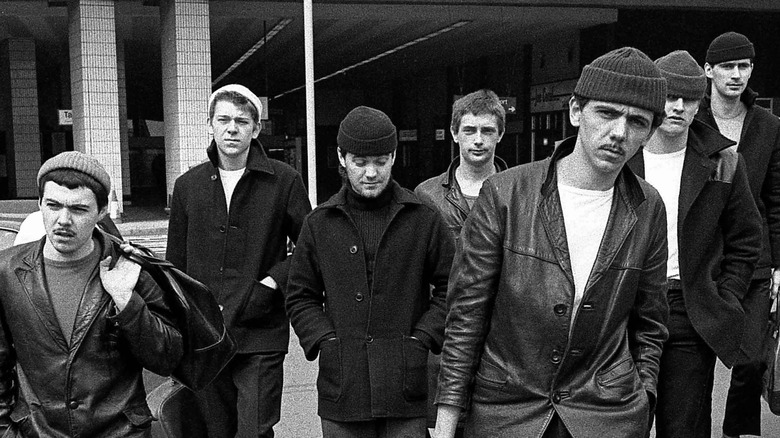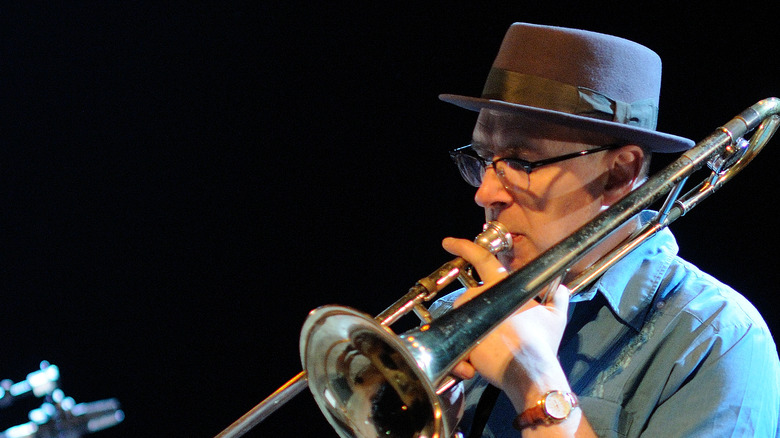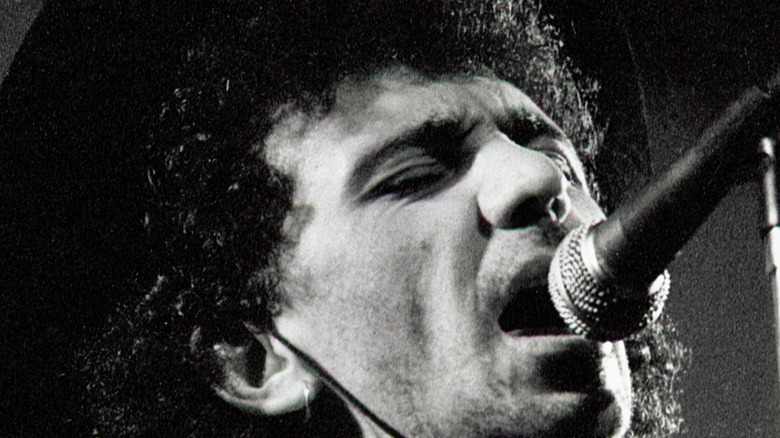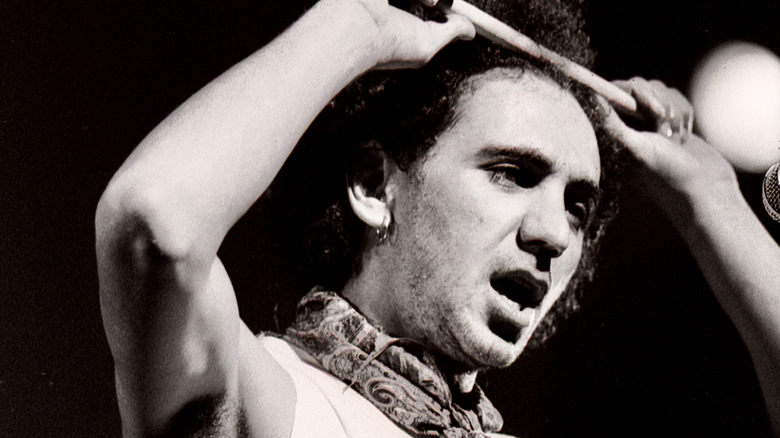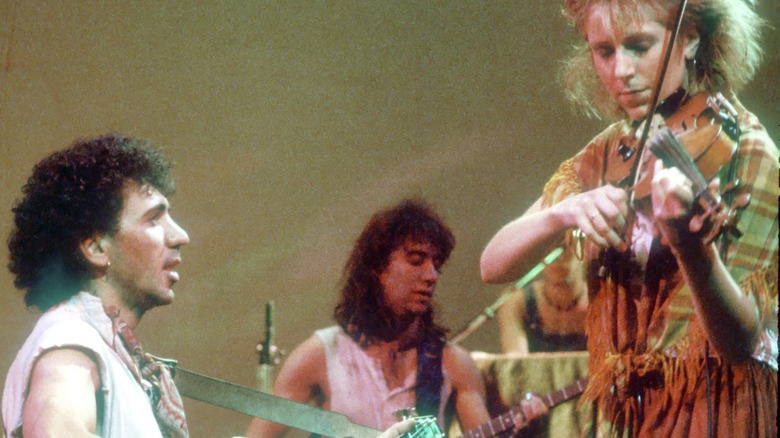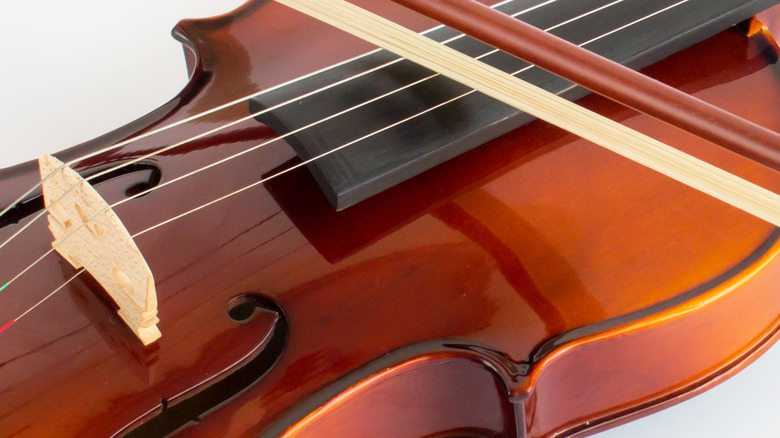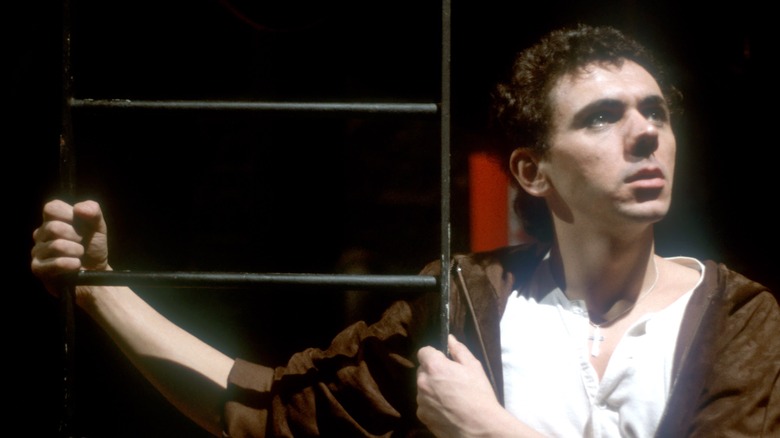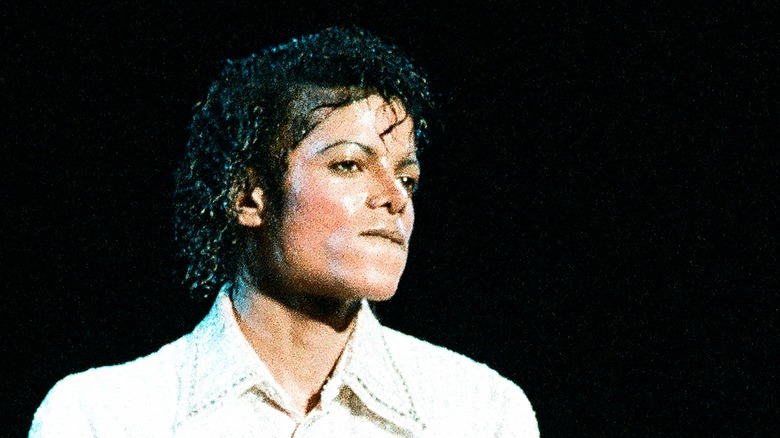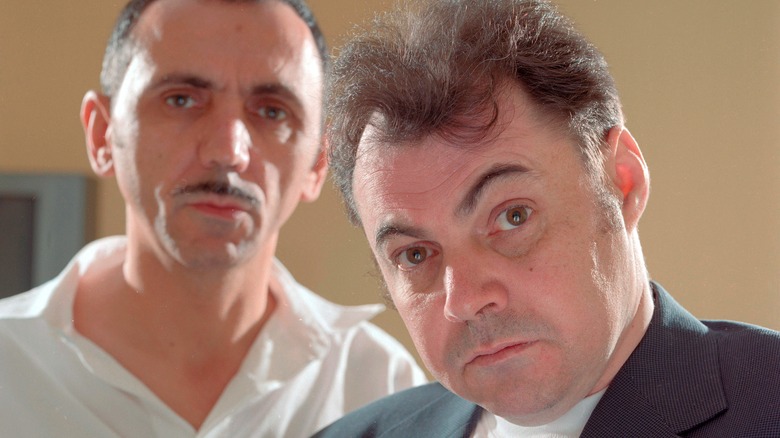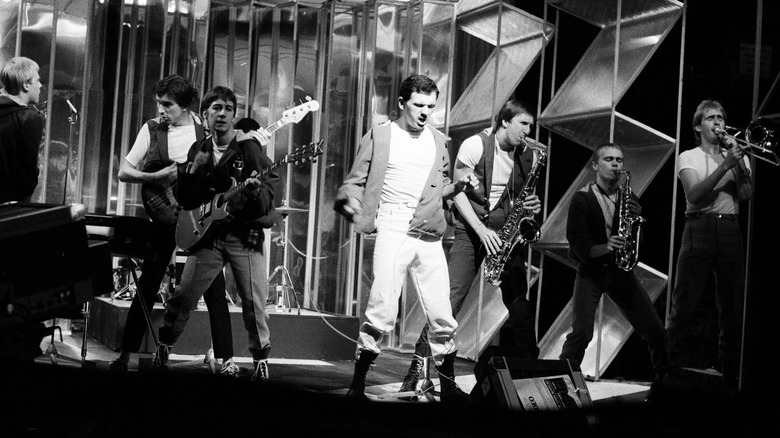The Untold Truth Of Dexys Midnight Runners
Dexys Midnight Runners is famous for their 1982 hit "Come on Eileen." It topped the U.S. charts, and has become a permanent staple on best of the '80s mixes. While it has become synonymous with the decade, "Come on Eileen" shares very little in common with anything else on the pop charts at the time.
The band itself was just as much of an anomaly as the song. They appeared on "Top of the Pops" after synthy Duran Duran, wearing worn denim overalls and playing trombones, fiddles, and accordions. The Guardian describes Dexys as "a Black Country soul band with Irish roots." Their influences were often more than a decade old, and the band's sound often has more in common with Celtic folk and American soul than pop. They are often associated with the rough, lived-in style that they wore in the music video for "Come on Eileen," but, as noted by The Independent, their look actually changed often. For one album, the band dressed in a style inspired by New York dock workers — for another, professional gray suits and skirts.
The band's unique sound and style was largely the work of songwriter and frontman Kevin Rowland, who was notorious for being a controlling perfectionist when it came to his artistic vision. This is the untold truth of Dexys Midnight Runners.
Rowland was arrested four times before he was 15
Dexys Midnight Runners was a band uniquely of its time and place. The United Kingdom in the 1980s was dominated by the reign of the notorious Maggie Thatcher. The famous mining strikes and the collapse of the coal, steel, and transportation industries led to a lack of opportunity for young people and an increase in crime. In a report from The Guardian, Professor Stephen Farrall explained that most young men expected to go into the same profession as their fathers. When their fathers lost their jobs, their plans for the future were destroyed. "Deindustrialisation took away young people's hope and aspirations when they were young by making their parents unemployed and hitting their own job prospects," Farrall explained. "That could lead to them turning to drugs and crime."
Kevin Rowland, founder and frontman of Dexys Midnight Runners, was a teenager in the late '60s and early '70s, but his early life experiences made him the perfect person to write songs that appealed to the disillusioned youth of '80s England. Rowland stated in an interview with The Big Issue that he had already been arrested four times before he left school at the age of 15 for things like stealing a scooter and trying doors.
"I left school ... thinking I was a complete failure," Rowland said. "My younger self couldn't offer much in a world where he had given up on his dreams."
They started out punk rock
The disillusionment in the late '70s and '80s also led to a cultural revolution, and as described by Jason Cowley for The Guardian, this manifested in a rise in political punk rock. Before Kevin Rowland started Dexys Midnight Runners, he was in a punk band known as The Killjoys.
In a 1977 interview, Rowland described how Birmingham's punk scene had started out relatively "laid back" compared to the thriving scene in London. Despite this, the group were able to release several songs with the label Damaged Goods. The label has stated that Rowland tried to use his then-girlfriend and bassist's sexuality to get more attention for the band.
While the band was supposed to be recording new songs for an album, inner turmoil led to the band splitting. As described in a documentary from the BBC, the band fell apart. Rowland and his bandmate, guitar player Kevin Archer, would go on to start a new band in an entirely different genre. "With punk ... it swept a lot of things away," Rowland said. "I knew that people would want to dance again."
Northern England was obsessed with soul
After the breakup of The Killjoys, Kevin Rowland and Kevin Archer formed a soul band. As improbable as it might seem for a young man from Birmingham in the late '70s to go from punk to soul, this was actually part of a wider trend known as the Northern Soul Scene.
As described by Louder Than War, Northern Soul was a movement that came from the mod scene in the 1960s. It took place in the North of England, but was inspired by the music of Black American soul. By the '70s, in Manchester and Lancashire, the style had its own dance style associated with it (one that some argue was inspired by Jackie Chan's karate fight scenes). It was also associated with the use of amphetamines.
As described by One Hit Wonderland's episode on "Come on Eileen," the scene embraced little-known soul records from the United States. Obscure songs, some of which were more than a decade old and had never been popular in the U.S., became hits in this niche subculture. Rowland would go on to include references to some of these soul deep cuts in Dexys Midnight Runners lyrics.
Dexys started when Killjoys quit
In an interview with The Guardian, Kevin Rowland stated that the Killjoys weren't very good, and he "already had an idea to form a big soul band with a brass section." Despite this, he was devastated when the band broke up. According to Rowland, he had booked a substantial gig for the Killjoys in London and paid for a van to take them there when he received a phone call from one of his bandmates, telling him that three of them were leaving the band.
Rowland and Kevin Archer put an ad in Melody Maker, looking for members for their new band. They auditioned more than 30 people for their new band, ultimately settling on around eight performers. Trombone player "Big” Jim Paterson described joining Dexys Midnight Runners as "a fluke."
As described by bassist Peter Williams in a BBC documentary, they were hoping to achieve a sound that had "a brassy sound but ... the aggression and immediacy that punk rock had." Keyboardist Mick Talbot stated that the band, "was something that came out of Birmingham, and it couldn't have come from anywhere else. It was very ... sincere in its ... appreciation of American R&B, but it was its own thing, and it felt for real."
They had a strict code of conduct
Dexys Midnight Runners was tightly controlled by Kevin Rowland and Kevin Archer, to the extent that keyboardist Andy Leek described them as "manufactured." This included the lives of the band members.
As described by the BBC documentary on Dexys, bandmates were not allowed to drink or take drugs before performing. At the beginning of the band's career, Rowland and Archer kicked several session musicians out of the band for having a beer before a gig. According to an article in The Guardian, Rowland also enforced an intense "fitness regime."
While they were known to practice for eight hours a day, they also did recreational activities together. According to Kevin Rowland, this included shoplifting. Bassist Peter Williams described how no one in the band owned a car, and they needed to go to London frequently to try to book gigs, so they would try to sneak around the train to avoid paying the conductor. "Some of the people had never done that before in their lives," Rowland stated of the band's shoplifting expeditions, "whereas I was more of an expert."
Dexys was named after amphetamines
While members of the band were forbidden to take drugs before performing, and until 1987, Rowland didn't personally take drugs, the band's name was a reference to the drug of choice of the Northern Soul scene: dextranphetomine, also known as dexedrine, or "dexy." As an amphetamine, dextranphetomine is a stimulant, so it's likely that "midnight runners" refers to people using the drug's typical hyperactivity.
After Dexys Midnight Runners broke up, Rowland struggled with addiction. According to an interview with The Guardian, he was dealing with guilt over his behavior in Dexys.
"I had lots of demons and pain in me, but they really came out in the last three years of my cocaine addiction," Rowland told Vice. "It just became my life; it took over ... I got into a program of recovery in '93, and that was like my protection. I'm still in it, and I've been clean ever since."
If you or anyone you know is struggling with addiction issues, help is available. Visit the Substance Abuse and Mental Health Services Administration website or contact SAMHSA's National Helpline at 1-800-662-HELP (4357).
Rowland controlled the band's unique look
Along with everything else, Kevin Rowland designed the look of the band, including their fashion. One look was inspired by NYC dock workers, such as those featured in "On the Waterfront." Their most iconic look, however, was the one worn for the "Come on Eileen" video. While the success of their video made people associate the band with the rough denim look, it was actually only the band's wardrobe for about a year before Rowland moved on to something else. "We were into the idea of being scruffy, but of course only in exactly the right kind of way," Rowland was quoted as saying in The Look.
Rowland may have had the ideas for the band's unique fashion, but the looks were actually made by costume designer Debbie Baxter. Baxter would present drawings of potential looks to the band. One of these were the "denim dungarees" that would become the band's signature style. They tried weathering their own denim by boiling it in Rowland's kitchen, but they ultimately went with actually used pieces. The band was "in tatters" at the time, and it was difficult to get everyone on board with the non-traditional look.
"I remember ... opening a big refuse sack and passing them round to the guys," Rowland recalled. "Some of them had already left the band and were only recording the album on a session basis ... There were guffaws from one or two, but eventually it all came together."
The band fought over fiddles
While in the United States, Dexys was a "one hit wonder," they actually had two hits in the U.K. The other was a song called "Geno."
As described on "One Hit Wonderland," Dexys was truly leaning into their Northern Soul origins for this song. The name is a reference to soul singer Geno Washington. The entire first album was powered by horns and had an old soul feel. For the second album, "Too Rye Aye" which featured "Come on Eileen," their sound gained another influence: Celtic folk.
The unique sound would push them into international success (and later become the source of controversy in Rowland's life), but it was unpopular with the band. Instead of horns, the new album featured fiddles. This is what led to the band being "in tatters," as Rowland described it. While they agreed to finish recording the album, the entire horn section officially quit to protest the change.
What the lyrics actually mean
A remarkable number of people only know the chorus of "Come on Eileen." This is likely because Kevin Rowland's singing voice can make it difficult to understand the lyrics. This is complicated by the fact that a nonsense phrase is prominent in the song. It is likely that "Too-ra-loo-rye-ay" is a nod to the band's new Celtic folk direction. The old Irish folk song "Courtin' in the Kitchen" features a similar sounding line, as does "That's An Irish Lullaby."
As for the titular Eileen, Rowland used to claim that she was his ex-girlfriend. In an interview with The Guardian, however, he admitted that she was a "composite" that he used to depict "Catholic repression." He described the experience of "being a teenager, surrounded by Irish Catholic girls you couldn't touch, but at the same time with these overpowering feelings of lust which you're not supposed to have."
Like many of Dexys' songs, there is a reference to another musician. In this case, Johnny Ray, who was popular in the '50s, with the generation before Rowland's own (hence the lyric, "we can sing just like our fathers.") The song has been interpreted as being about someone desperate to get out of his hometown (where people are "beaten down" and "resigned to their fate,") and find happiness elsewhere. Whether or not the song is autobiographical has never been explicitly stated, but it would seem to parallel elements of Rowland's experience.
They were (briefly) bigger than Michael Jackson
Although Dexys Midnight Runners have become eternally associated with the '80s, thanks to the success of "Come on Eileen," its sound is unique not only for the year of its release, but for the decade.
As described in a 2019 article in the Journal of Popular Music Studies, the '80s are typically associated with electric pianos (which can be heard in a staggering 61% of No. 1 hits of the '80s, across genre lines) and synthesizers, which took pop music by storm with the new genre "electro-pop" or "synthpop." Dexys had an entirely different sound. While they had cut back on the amount of horns for their second album, they were still present in "Come on Eileen," showing the "big soul band with a brass section" Kevin Rowland had cultivated (via The Guardian). Their Celtic folk influence was represented by the fiddles that had caused so much strife in the band.
Unlike the obscure soul records that had influenced Dexys, along with the Northern Soul Scene years after they were released, "Come on Eileen" was a massive hit in its own time. As stated by The Wall Street Journal, it became a No. 1 hit in 1983, taking the slot from Michael Jackson's "Billie Jean."
The hit was 'stolen'
In 1997, Kevin Rowland released an apology, stating that he "felt like a total fraud, and unworthy and unable to deal with the acclaim that came my way." As reported in The Independent, Rowland believed that he had stolen "the idea and sound" for "Come on Eileen" from his former bandmate Kevin Archer. He apologized for "conning" his friends, bandmates, and fans by claiming the work was his own.
As Rowland would later tell The Guardian, he was in a very "dark place" at the time of his confession, and had come to believe that he had "no talent" and couldn't be responsible for the band's success. While Archer has not offered his side of the story, it seems that Archer played his demos for Rowland, when they were still friends. According to Rowland, Archer had been working on "a combination of Tamla-style beat with violins." Rowland liked the sound that Archer had come up with, and used it for their second album "Too Rye Aye," and the hit "Come on Eileen." Rowland clarified that while he did take the style, he wrote the songs on the album himself, and "didn't steal one note, one chord, one melody."
Their last album was a flop, but might be a masterpiece
As described by Dexys saxophone player Nick Gatfield on BBC Radio 4's "Follow-Up Albums," "There was an element of anticipation and nervousness about the way they approached the follow up [to "Come on Eileen"] ... it was a global phenomenon, that record, and how do you follow it up? I think Kevin [Rowland] really felt the pressure."
The next album was called "Don't Stand Me Down." It was more ambitious than any Dexys album ever before. It took nine months to write, featured spoken word dialogue, and the songs were between five and 12 minutes long. As noted on "One Hit Wonderland," Rowland again changed the band's look for the album, this time featuring mostly gray office attire. Rowland refused to record the album unless it could be recorded live, with all of the band members playing at the same time. He initially refused to release a single, believing that the album worked best when listened to as a full album, in the right order. After listening to the demo, a manager warned Rowland that it might not be successful, but Rowland wasn't deterred. He felt he had nothing to lose.
The album did terribly at the time, both rejected by critics and the public. Today, it is still obscure, but it has gained a great deal of critical respect. Fans of the band often consider it the best work of Dexys Midnight Runners.
